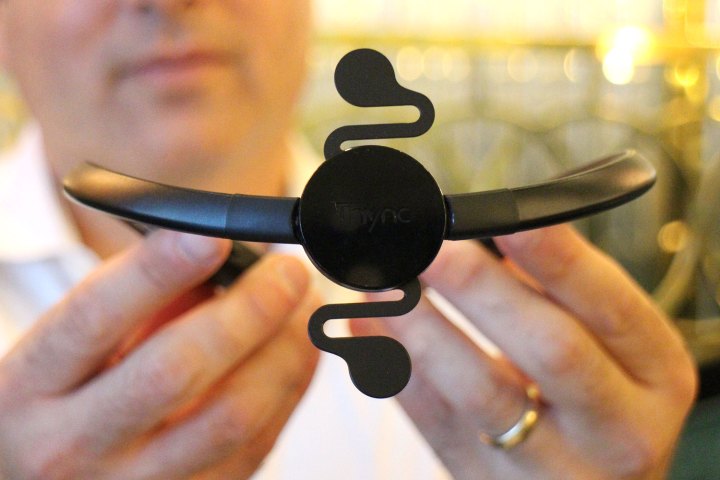
The contents of my wallet didn’t quite cover the £500 I’d need to secure a room at the Savoy Hotel, which was a pain, because the thought of fighting my way through the horror of central London, and then on the constantly striking trains home really didn’t appeal. It was all Thync’s fault. Stuck to the back of my neck was a version two prototype of its fascinating, mind-altering wearable, and it was proving ridiculously effective.
Thync is a pro-active wearable device in that it does something, rather than simply tracks something. It’s designed by neuroscientists, and it zaps ultrasound waves directly to your brain to either relax or stimulate you. Thync can calm you down, or rev you up. Now, Thync is back with a new model that’s very different from the first. It improves usability, increases the friendliness of the wearable, and keenly focuses its functionality.
It’s currently known as Thync Relax, and it does away with the stimulation aspect, concentrating instead on reducing stress and calming you down. Thync CEO Isy Goldwasser told Digital Trends that although there were those who enjoyed the stimulation mode on the original model, twice as many were using it for relaxation, and most were using it in the evening or before bed. Stress, as if we didn’t know, is a massive problem and clearly, one people are keen to address through relaxation.
New friendlier design
Obviously, many of the traditional methods, including coffee, alcohol, or less legal drugs, aren’t very good for us. Time and scheduling don’t always allow for a time-out either. That’s where Thync comes in. It uses Transcranial Direct Current Stimulation, or tDCS, and not only is it safe, but our body doesn’t build up a tolerance to it, either. In other words, we won’t end up having to use Thync for 24-hours to replicate an effect that once took 10 minutes. Thync Relax uses the same technology, calming our mind down in a matter of minutes, but delivers tDCS in a different way.
The tech world is gradually waking up to the fact our gadgets contribute to our stress, and that’s where Thync comes in.
Rather than the forehead-mounted module with printed circuit straps leading to the back of your head, Thync Relax will be a halo-style wearable for the neck. Think LG’s Tone Platinum or Samsung’s Level U headphones, and you’re on the right track. It’ll feel just as comfortable as either of those devices, too. The sensors needed to transmit the current will be part of the band, falling on the right spot on the back of the neck. The result will be a wearable that’s inconspicuous, won’t make you look like a budding member of the Borg, and will require way less effort to put on and use. It’s a considerable step forward in bringing Thync’s benefits to more people.
We saw a prototype, non-working version, but also had the chance to try out a demo unit that replicated the Thync Relax’s positioning and a couple of new Vibes. Vibes are the name given to Thync’s varied programs, most of which last for 10 minutes, and produce subtly different effects. Seated in the Savoy’s Kasper restaurant at lunch time, Goldwasser attached the Thync Relax to my neck and left me on my own to enjoy the experience.
You’ll get that tingly feeling
Having used Thync on a variety of occasions in the past, I was used to the tingling sensation, but I noticed that it’s more manageable than before. With Thync on the forehead, the tingling isn’t painful, but it’s definitely unusual, and sometimes felt a little alien — as if the body was saying “you shouldn’t really do that.” There’s none of that with the neck-only sensors, and I was able to up the intensity of the Vibe more than usual.
I didn’t feel any different for the first five minutes. The Vibe lowered the intensity for a short while, then pushed it further up than before, which is when I noticed a change in feeling. My legs stretched out, I rested my head on my hands with my elbows on the table, and with three minutes to go, didn’t really care if Goldwasser forgot to look at his watch and let me be. All this relaxation happened in a very fancy and busy London restaurant. It was a good thing he did come back, though because he activated a five-minute booster afterwards that really emphasised the effectiveness of Thync. The sensation was spikier than before, and the effect was stronger.
Coming off a very busy trade show, an Apple launch event, and various other activities, I was pretty tired anyway, but was worked up for the meeting. You know that feeling when it’s time for sleep, and the brain gets slightly fuzzy in an incredibly relaxed way? Thync Relax made me feel like that, and thinking of intelligent, insightful questions afterwards was a particular challenge. If the money had been in my wallet, I would have made my excuses to leave, paid for a room and headed off for a snooze. It wasn’t very long lasting, though, and my sleepiness cleared after 30 minutes, but probably only because I had to go out and do stuff.
Goldwasser also talked about the near future for Thync, saying that although the Vibes are one-size-fits-all now, it’ll soon become possible to tailor them for individual needs and tastes. This way, relaxing the mind and body will be less hit-and-miss, and you’ll be in the desired zone much quicker. Additionally, as the software is refined, the amount of time needed to get to that zone will be reduced, with programs potentially needing just a few minutes rather than 10. Thync Relax may also be joined by another version in the future too, and mention was made of a dedicated Thync Boost to replicate the Energy Vibes.
Wider appeal
For now, though, it’s all about the Thync Relax. To go along with the less sci-fi, more acceptable to everyday people design, and the simplified application process, Thync’s planning a U.K. launch shortly after its U.S. debut, and to sell it through Amazon in addition to its own online store, therefore making it easier for more people to buy. The price will be around the same, approximately $300, and although you will often need to buy new sticky contacts for the back of the neck due to their limited lifetime, they will be cheaper than the current strips. The intention is to have it on sale during spring 2017.
The tech world is gradually waking up to the fact our gadgets contribute to our stress, and mindfulness can only do so much — That’s where Thync comes in. Wearables are evolving too, becoming less about solely fitness tracking and more about improving our lifestyle and health. Thync straddles the two worlds. While before it really only appealed to the geeky early adopter — “Thync was like a 10,000-person beta test,” Goldwasser told Digital Trends, referring to how many people are currently using the first version — Thync Relax is more open and ready to help more people.
In our limited exposure, Thync Relax appears to have lost none of its potency during this transition. However, Thync has had a tumultuous 2016, suffering at the hands of investors, cutting staff, and holding auctions to keep things going. During this period, the chief science officer left the company, and headcount apparently fell to 10. Now, with new investment and plans to raise further capital through investor-focused crowdsourcing platforms, it seems ready to put that behind it with the Thync Relax; but we won’t know for sure if the recovery has worked until it hits the shelves.
Highs:
- Relaxing to the point of dozing off
- Final version promises to be comfortable and inconspicuous
- More focused approach to functionality
- Easy to wear, less complicated to set up
Lows:
- Conductive strips have a limited life
- Ongoing payments to stock up on strips





